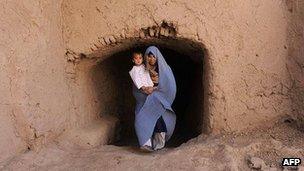Afghanistan maternal mortality drops, survey suggests
- Published

The figures reflect improving standards in Afghan antenatal care in recent years
Many more Afghan women are surviving pregnancy and childbirth than was thought, a new survey suggests.
The research puts maternal mortality rates below 500 deaths per 100,000 live births. A UN study in 2005 found 1,800 women dying per 100,000 live births.
The new study also suggests a dramatic decrease in infant and child mortality rates over the last five years.
Correspondents say the figures reflect improving standards in antenatal care but the overall picture is still grim.
The Afghanistan Mortality Survey (AMS) 2010 was carried out by the health ministry, and is the most comprehensive of its kind ever carried out in the country.
It was sponsored and funded by international organisations such as Unicef, the World Health Organisation, the US government and the British Department for International Development.
Experts are encouraged by what they say are dramatic improvements in mortality rates, but all the same Afghanistan remains one of the most dangerous places in the world to be a pregnant woman or a young child.
The 2010 survey reveals that infant and under-fives mortality rates appear to be decreasing, with infant mortality now around 77 deaths per 1,000 live births and under-fives child mortality at around 97 deaths per 1,000 child births.
One in 10 children in Afghanistan still dies before they are five years old, the survey said.
Officials say that it is difficult to compare the latest data with previous surveys which were based on geographically limited and less representative samples.
But correspondents say research about five years ago suggested that one in five children died before reaching the age of five.
A 2009 World Health Organisation study found 199 under-fives child deaths per 1,000 live births.
However the latest survey indicates that despite the more encouraging figures, complications from pregnancy and childbirth still posed significant risks to women and accounted for about two in five deaths in women aged 15-49.
It says that an Afghan woman dies every two hours from pregnancy-related causes.
The survey covered 87% of the population of the country - 98% of the urban population and 84% of the rural population.
It also showed that the estimated life expectancy is up to between 62 and 64 years for men and women. Previous studies conducted by the UN in 2009 showed life expectancy to range from 47 to 50 years old.
Afghan Save the Children Country Director David Skinner said that the latest statistics were encouraging in what was a challenging and difficult environment.
"Since 2003, around 20,000 community health workers and 2,500 midwives have been trained," he said.
"As a result of this and other community-level activities, fewer children are dying from preventable causes like diarrhoea or pneumonia.
"These results also show that international aid, which has funded many of the public health programmes in Afghanistan, has made a real difference - saving many children's lives.
"But donor governments need to build on this success, and continue to invest in Afghanistan in ways that directly benefit ordinary Afghans," he said.
The AMS was carried out by the Afghan public health ministry and central statistics organisation.
For security reasons, rural areas of Kandahar, Helmand and Zabul were excluded from the survey, but urban areas of these provinces were included.